Business Finance Report: T-shirt Ltd Performance Analysis and Cash
VerifiedAdded on 2023/01/05
|12
|3327
|69
Report
AI Summary
This report provides a comprehensive analysis of business finance, focusing on the performance of T-shirt Ltd and its cash management strategies. It begins with an introduction to business financing and then delves into a detailed examination of the company's financial statements, including the profit and loss account and balance sheet. The report analyzes key financial ratios such as gross profit ratio, net profit ratio, current ratio, and receivable turnover ratio to assess the company's financial health. Furthermore, the report explores the differences between accrual and cash accounting methods, highlighting their advantages and disadvantages. It also discusses the relationship between profit and cash flow, emphasizing the importance of managing both effectively for business success. The analysis provides a clear understanding of financial statements, key ratios, and accounting methods, contributing to a deeper understanding of business finance.

Business Finance
Paraphrase This Document
Need a fresh take? Get an instant paraphrase of this document with our AI Paraphraser

Table of Contents
INTRODUCTION...........................................................................................................................3
INTRODUCTION...........................................................................................................................3
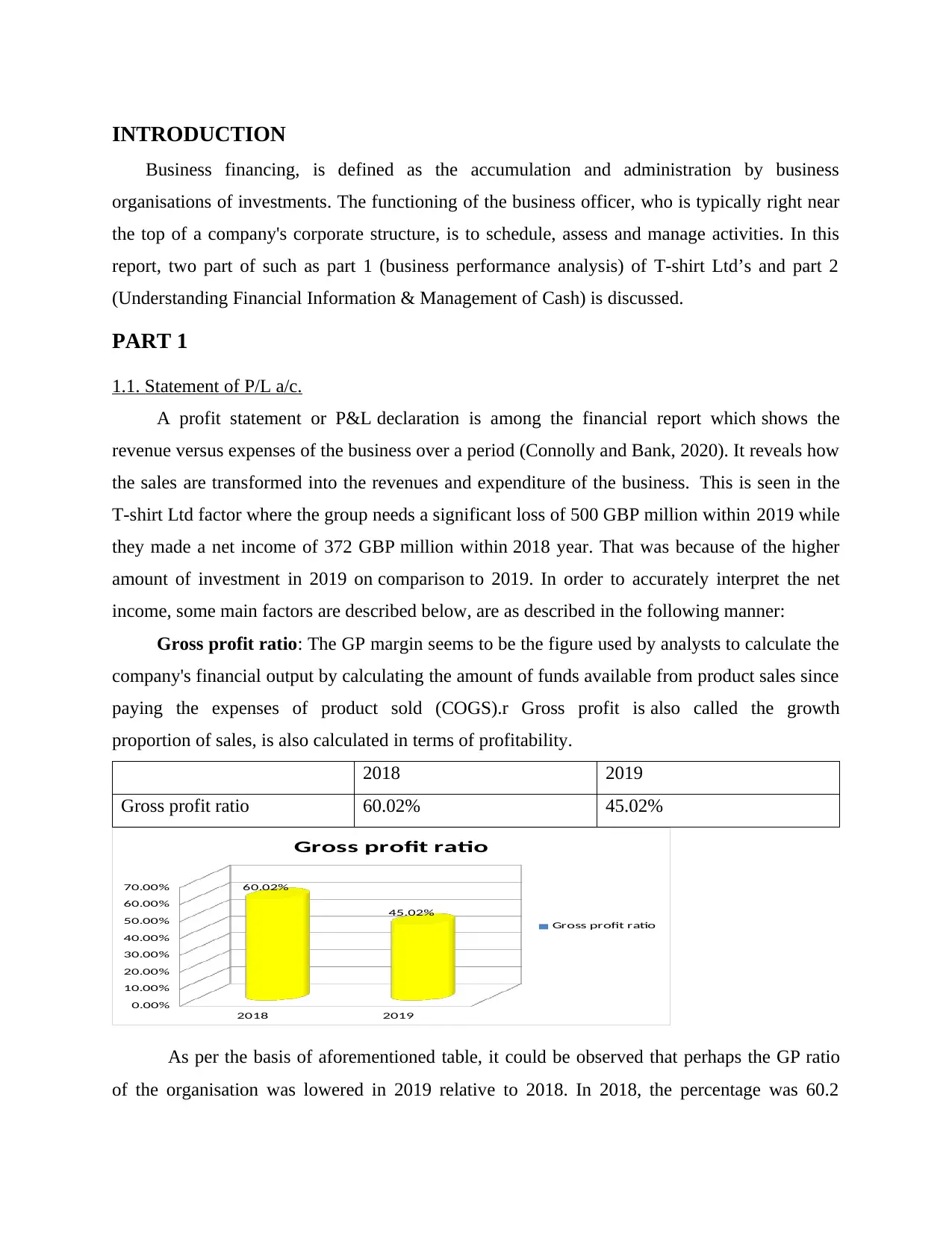
INTRODUCTION
Business financing, is defined as the accumulation and administration by business
organisations of investments. The functioning of the business officer, who is typically right near
the top of a company's corporate structure, is to schedule, assess and manage activities. In this
report, two part of such as part 1 (business performance analysis) of T-shirt Ltd’s and part 2
(Understanding Financial Information & Management of Cash) is discussed.
PART 1
1.1. Statement of P/L a/c.
A profit statement or P&L declaration is among the financial report which shows the
revenue versus expenses of the business over a period (Connolly and Bank, 2020). It reveals how
the sales are transformed into the revenues and expenditure of the business. This is seen in the
T-shirt Ltd factor where the group needs a significant loss of 500 GBP million within 2019 while
they made a net income of 372 GBP million within 2018 year. That was because of the higher
amount of investment in 2019 on comparison to 2019. In order to accurately interpret the net
income, some main factors are described below, are as described in the following manner:
Gross profit ratio: The GP margin seems to be the figure used by analysts to calculate the
company's financial output by calculating the amount of funds available from product sales since
paying the expenses of product sold (COGS).r Gross profit is also called the growth
proportion of sales, is also calculated in terms of profitability.
2018 2019
Gross profit ratio 60.02% 45.02%
2018 2019
0.00%
10.00%
20.00%
30.00%
40.00%
50.00%
60.00%
70.00% 60.02%
45.02%
Gross profit ratio
Gross profit ratio
As per the basis of aforementioned table, it could be observed that perhaps the GP ratio
of the organisation was lowered in 2019 relative to 2018. In 2018, the percentage was 60.2
Business financing, is defined as the accumulation and administration by business
organisations of investments. The functioning of the business officer, who is typically right near
the top of a company's corporate structure, is to schedule, assess and manage activities. In this
report, two part of such as part 1 (business performance analysis) of T-shirt Ltd’s and part 2
(Understanding Financial Information & Management of Cash) is discussed.
PART 1
1.1. Statement of P/L a/c.
A profit statement or P&L declaration is among the financial report which shows the
revenue versus expenses of the business over a period (Connolly and Bank, 2020). It reveals how
the sales are transformed into the revenues and expenditure of the business. This is seen in the
T-shirt Ltd factor where the group needs a significant loss of 500 GBP million within 2019 while
they made a net income of 372 GBP million within 2018 year. That was because of the higher
amount of investment in 2019 on comparison to 2019. In order to accurately interpret the net
income, some main factors are described below, are as described in the following manner:
Gross profit ratio: The GP margin seems to be the figure used by analysts to calculate the
company's financial output by calculating the amount of funds available from product sales since
paying the expenses of product sold (COGS).r Gross profit is also called the growth
proportion of sales, is also calculated in terms of profitability.
2018 2019
Gross profit ratio 60.02% 45.02%
2018 2019
0.00%
10.00%
20.00%
30.00%
40.00%
50.00%
60.00%
70.00% 60.02%
45.02%
Gross profit ratio
Gross profit ratio
As per the basis of aforementioned table, it could be observed that perhaps the GP ratio
of the organisation was lowered in 2019 relative to 2018. In 2018, the percentage was 60.2
⊘ This is a preview!⊘
Do you want full access?
Subscribe today to unlock all pages.

Trusted by 1+ million students worldwide
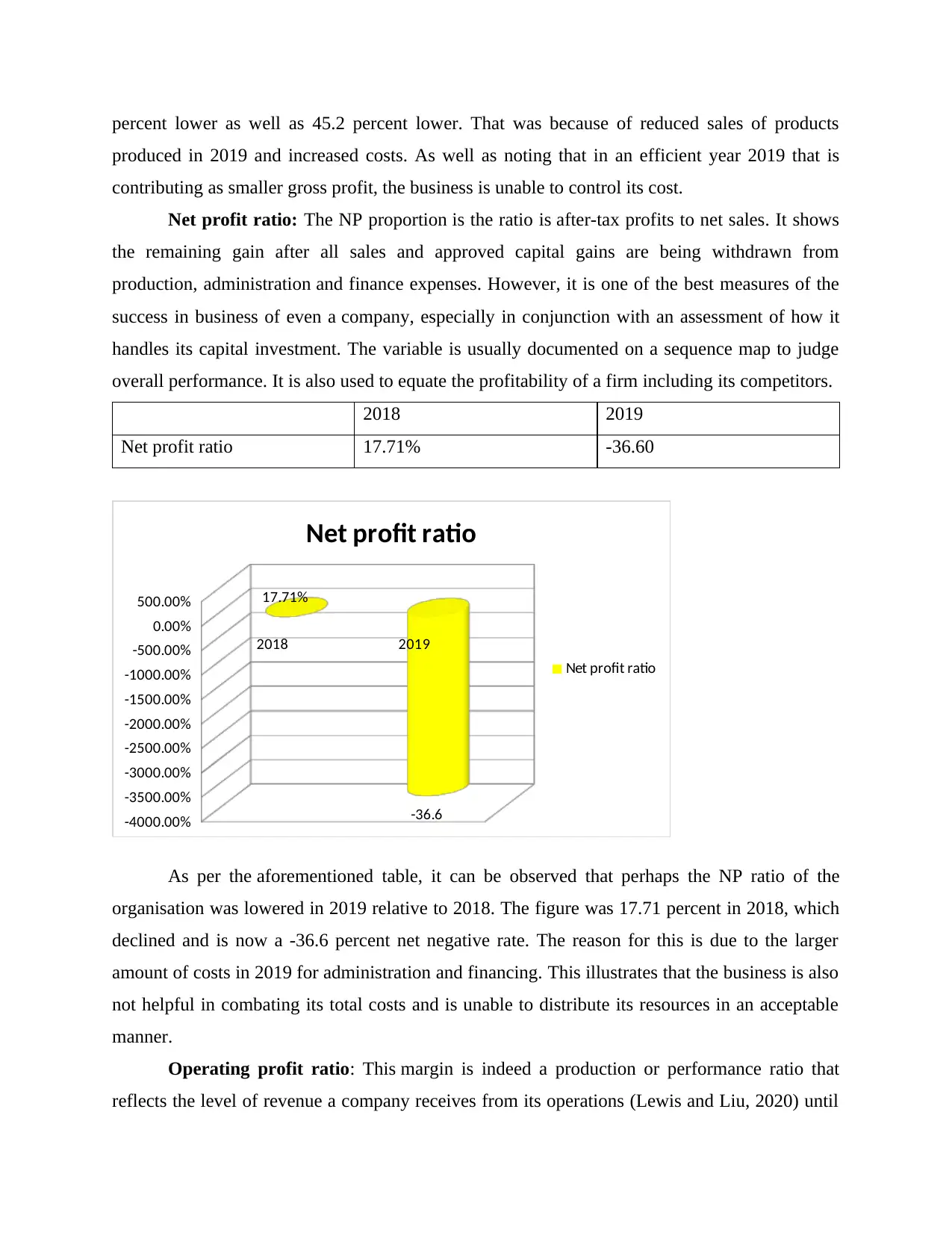
percent lower as well as 45.2 percent lower. That was because of reduced sales of products
produced in 2019 and increased costs. As well as noting that in an efficient year 2019 that is
contributing as smaller gross profit, the business is unable to control its cost.
Net profit ratio: The NP proportion is the ratio is after-tax profits to net sales. It shows
the remaining gain after all sales and approved capital gains are being withdrawn from
production, administration and finance expenses. However, it is one of the best measures of the
success in business of even a company, especially in conjunction with an assessment of how it
handles its capital investment. The variable is usually documented on a sequence map to judge
overall performance. It is also used to equate the profitability of a firm including its competitors.
2018 2019
Net profit ratio 17.71% -36.60
2018 2019
-4000.00%
-3500.00%
-3000.00%
-2500.00%
-2000.00%
-1500.00%
-1000.00%
-500.00%
0.00%
500.00% 17.71%
-36.6
Net profit ratio
Net profit ratio
As per the aforementioned table, it can be observed that perhaps the NP ratio of the
organisation was lowered in 2019 relative to 2018. The figure was 17.71 percent in 2018, which
declined and is now a -36.6 percent net negative rate. The reason for this is due to the larger
amount of costs in 2019 for administration and financing. This illustrates that the business is also
not helpful in combating its total costs and is unable to distribute its resources in an acceptable
manner.
Operating profit ratio: This margin is indeed a production or performance ratio that
reflects the level of revenue a company receives from its operations (Lewis and Liu, 2020) until
produced in 2019 and increased costs. As well as noting that in an efficient year 2019 that is
contributing as smaller gross profit, the business is unable to control its cost.
Net profit ratio: The NP proportion is the ratio is after-tax profits to net sales. It shows
the remaining gain after all sales and approved capital gains are being withdrawn from
production, administration and finance expenses. However, it is one of the best measures of the
success in business of even a company, especially in conjunction with an assessment of how it
handles its capital investment. The variable is usually documented on a sequence map to judge
overall performance. It is also used to equate the profitability of a firm including its competitors.
2018 2019
Net profit ratio 17.71% -36.60
2018 2019
-4000.00%
-3500.00%
-3000.00%
-2500.00%
-2000.00%
-1500.00%
-1000.00%
-500.00%
0.00%
500.00% 17.71%
-36.6
Net profit ratio
Net profit ratio
As per the aforementioned table, it can be observed that perhaps the NP ratio of the
organisation was lowered in 2019 relative to 2018. The figure was 17.71 percent in 2018, which
declined and is now a -36.6 percent net negative rate. The reason for this is due to the larger
amount of costs in 2019 for administration and financing. This illustrates that the business is also
not helpful in combating its total costs and is unable to distribute its resources in an acceptable
manner.
Operating profit ratio: This margin is indeed a production or performance ratio that
reflects the level of revenue a company receives from its operations (Lewis and Liu, 2020) until
Paraphrase This Document
Need a fresh take? Get an instant paraphrase of this document with our AI Paraphraser
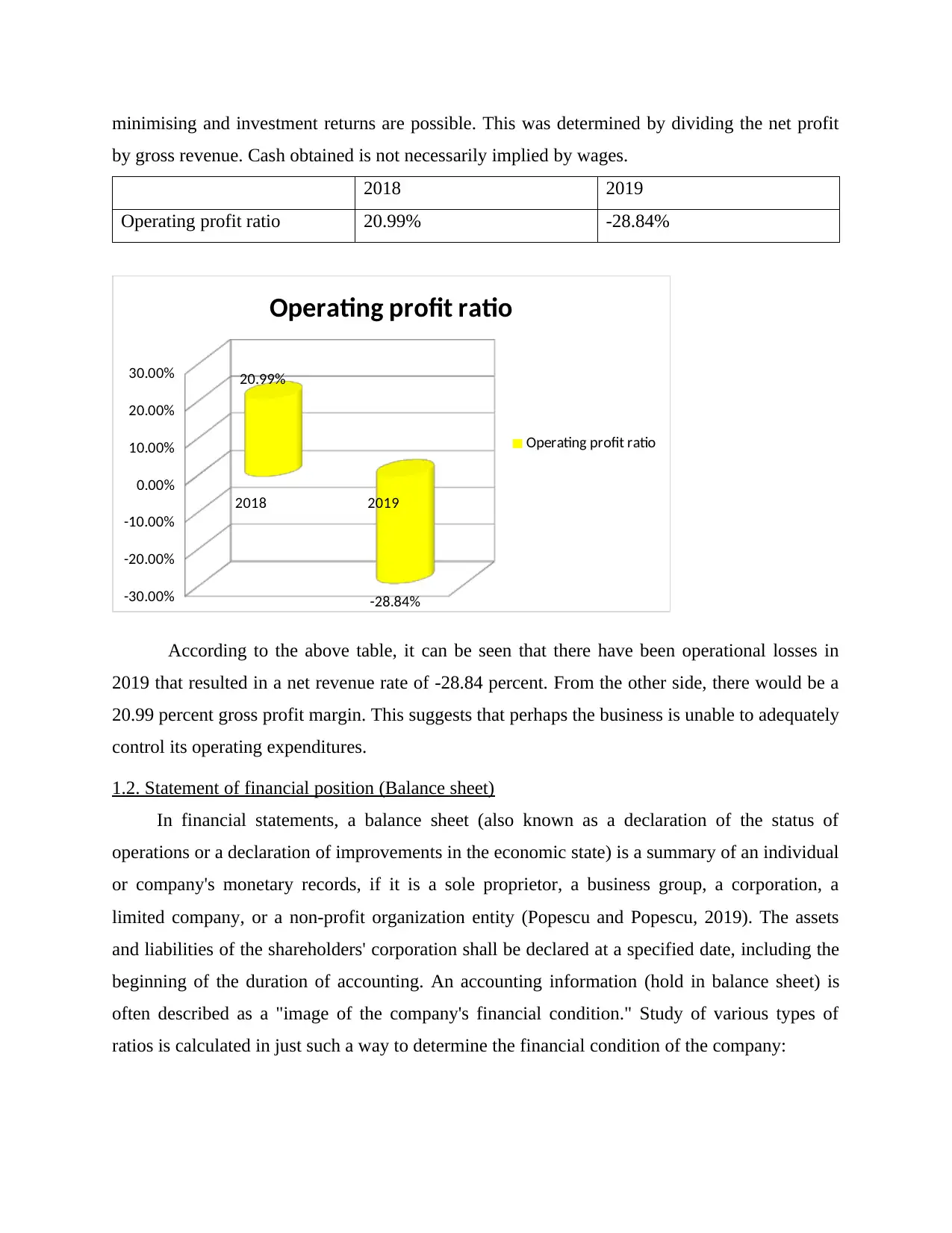
minimising and investment returns are possible. This was determined by dividing the net profit
by gross revenue. Cash obtained is not necessarily implied by wages.
2018 2019
Operating profit ratio 20.99% -28.84%
2018 2019
-30.00%
-20.00%
-10.00%
0.00%
10.00%
20.00%
30.00% 20.99%
-28.84%
Operating profit ratio
Operating profit ratio
According to the above table, it can be seen that there have been operational losses in
2019 that resulted in a net revenue rate of -28.84 percent. From the other side, there would be a
20.99 percent gross profit margin. This suggests that perhaps the business is unable to adequately
control its operating expenditures.
1.2. Statement of financial position (Balance sheet)
In financial statements, a balance sheet (also known as a declaration of the status of
operations or a declaration of improvements in the economic state) is a summary of an individual
or company's monetary records, if it is a sole proprietor, a business group, a corporation, a
limited company, or a non-profit organization entity (Popescu and Popescu, 2019). The assets
and liabilities of the shareholders' corporation shall be declared at a specified date, including the
beginning of the duration of accounting. An accounting information (hold in balance sheet) is
often described as a "image of the company's financial condition." Study of various types of
ratios is calculated in just such a way to determine the financial condition of the company:
by gross revenue. Cash obtained is not necessarily implied by wages.
2018 2019
Operating profit ratio 20.99% -28.84%
2018 2019
-30.00%
-20.00%
-10.00%
0.00%
10.00%
20.00%
30.00% 20.99%
-28.84%
Operating profit ratio
Operating profit ratio
According to the above table, it can be seen that there have been operational losses in
2019 that resulted in a net revenue rate of -28.84 percent. From the other side, there would be a
20.99 percent gross profit margin. This suggests that perhaps the business is unable to adequately
control its operating expenditures.
1.2. Statement of financial position (Balance sheet)
In financial statements, a balance sheet (also known as a declaration of the status of
operations or a declaration of improvements in the economic state) is a summary of an individual
or company's monetary records, if it is a sole proprietor, a business group, a corporation, a
limited company, or a non-profit organization entity (Popescu and Popescu, 2019). The assets
and liabilities of the shareholders' corporation shall be declared at a specified date, including the
beginning of the duration of accounting. An accounting information (hold in balance sheet) is
often described as a "image of the company's financial condition." Study of various types of
ratios is calculated in just such a way to determine the financial condition of the company:
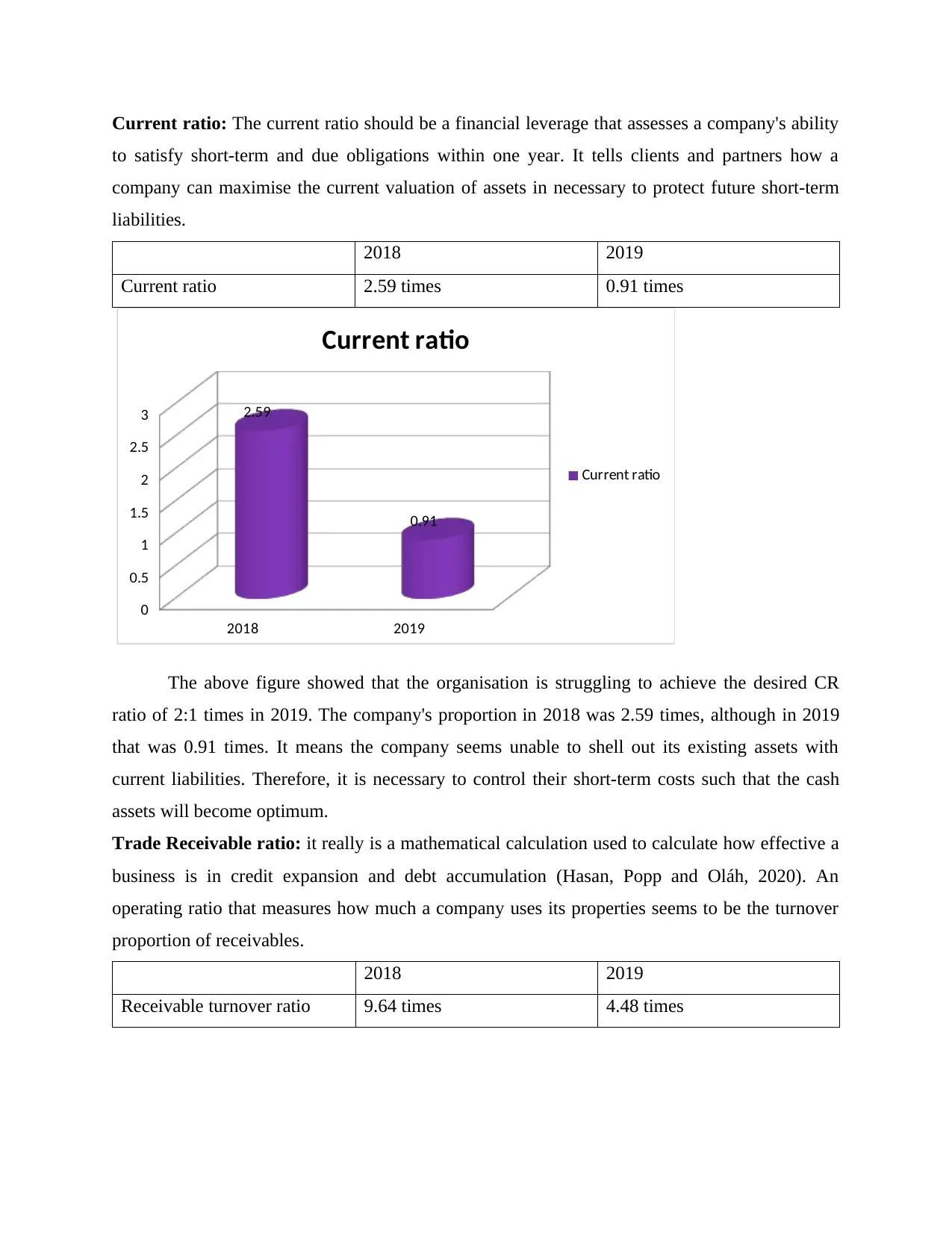
Current ratio: The current ratio should be a financial leverage that assesses a company's ability
to satisfy short-term and due obligations within one year. It tells clients and partners how a
company can maximise the current valuation of assets in necessary to protect future short-term
liabilities.
2018 2019
Current ratio 2.59 times 0.91 times
2018 2019
0
0.5
1
1.5
2
2.5
3 2.59
0.91
Current ratio
Current ratio
The above figure showed that the organisation is struggling to achieve the desired CR
ratio of 2:1 times in 2019. The company's proportion in 2018 was 2.59 times, although in 2019
that was 0.91 times. It means the company seems unable to shell out its existing assets with
current liabilities. Therefore, it is necessary to control their short-term costs such that the cash
assets will become optimum.
Trade Receivable ratio: it really is a mathematical calculation used to calculate how effective a
business is in credit expansion and debt accumulation (Hasan, Popp and Oláh, 2020). An
operating ratio that measures how much a company uses its properties seems to be the turnover
proportion of receivables.
2018 2019
Receivable turnover ratio 9.64 times 4.48 times
to satisfy short-term and due obligations within one year. It tells clients and partners how a
company can maximise the current valuation of assets in necessary to protect future short-term
liabilities.
2018 2019
Current ratio 2.59 times 0.91 times
2018 2019
0
0.5
1
1.5
2
2.5
3 2.59
0.91
Current ratio
Current ratio
The above figure showed that the organisation is struggling to achieve the desired CR
ratio of 2:1 times in 2019. The company's proportion in 2018 was 2.59 times, although in 2019
that was 0.91 times. It means the company seems unable to shell out its existing assets with
current liabilities. Therefore, it is necessary to control their short-term costs such that the cash
assets will become optimum.
Trade Receivable ratio: it really is a mathematical calculation used to calculate how effective a
business is in credit expansion and debt accumulation (Hasan, Popp and Oláh, 2020). An
operating ratio that measures how much a company uses its properties seems to be the turnover
proportion of receivables.
2018 2019
Receivable turnover ratio 9.64 times 4.48 times
⊘ This is a preview!⊘
Do you want full access?
Subscribe today to unlock all pages.

Trusted by 1+ million students worldwide
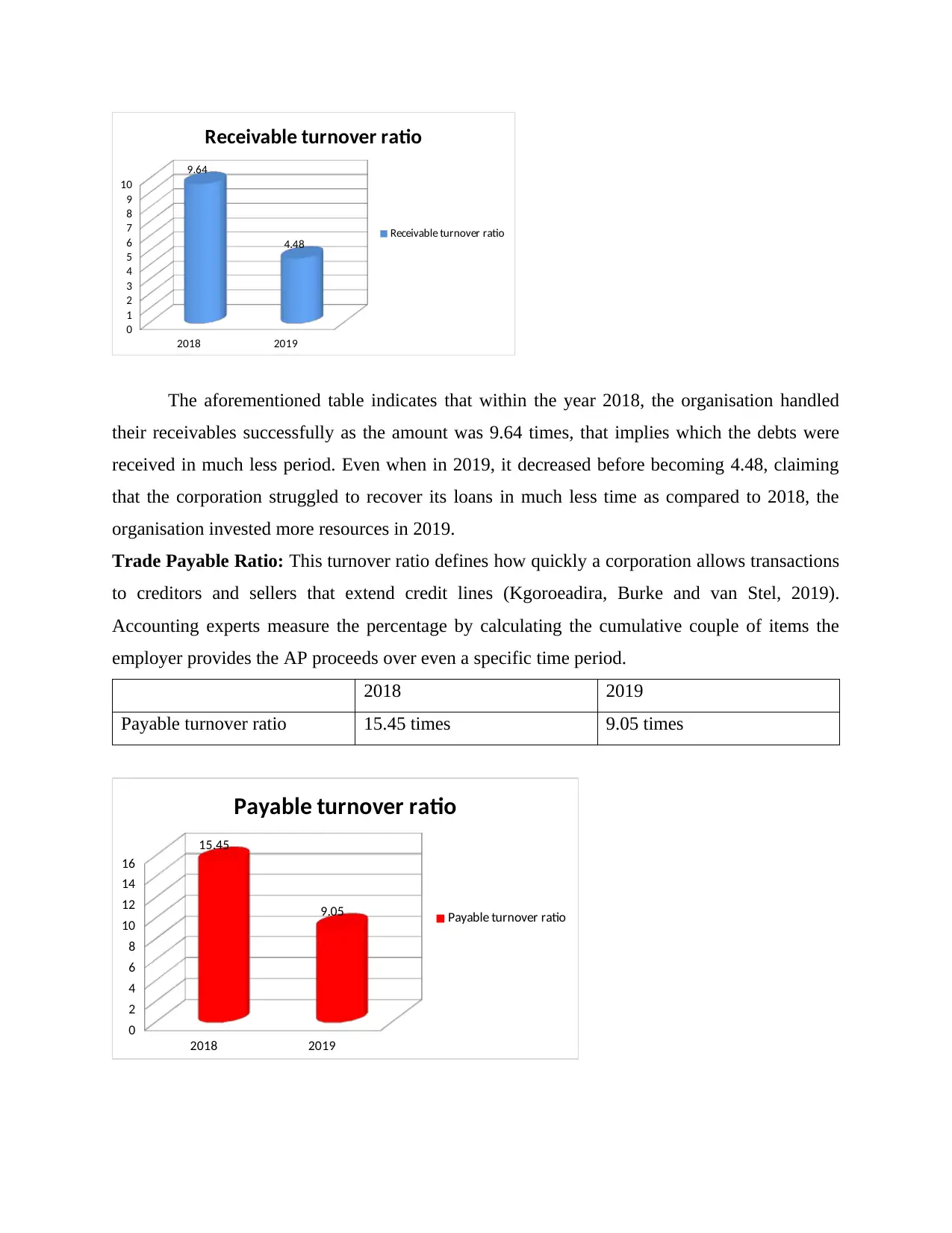
2018 2019
0
1
2
3
4
5
6
7
8
9
10
9.64
4.48
Receivable turnover ratio
Receivable turnover ratio
The aforementioned table indicates that within the year 2018, the organisation handled
their receivables successfully as the amount was 9.64 times, that implies which the debts were
received in much less period. Even when in 2019, it decreased before becoming 4.48, claiming
that the corporation struggled to recover its loans in much less time as compared to 2018, the
organisation invested more resources in 2019.
Trade Payable Ratio: This turnover ratio defines how quickly a corporation allows transactions
to creditors and sellers that extend credit lines (Kgoroeadira, Burke and van Stel, 2019).
Accounting experts measure the percentage by calculating the cumulative couple of items the
employer provides the AP proceeds over even a specific time period.
2018 2019
Payable turnover ratio 15.45 times 9.05 times
2018 2019
0
2
4
6
8
10
12
14
16
15.45
9.05
Payable turnover ratio
Payable turnover ratio
0
1
2
3
4
5
6
7
8
9
10
9.64
4.48
Receivable turnover ratio
Receivable turnover ratio
The aforementioned table indicates that within the year 2018, the organisation handled
their receivables successfully as the amount was 9.64 times, that implies which the debts were
received in much less period. Even when in 2019, it decreased before becoming 4.48, claiming
that the corporation struggled to recover its loans in much less time as compared to 2018, the
organisation invested more resources in 2019.
Trade Payable Ratio: This turnover ratio defines how quickly a corporation allows transactions
to creditors and sellers that extend credit lines (Kgoroeadira, Burke and van Stel, 2019).
Accounting experts measure the percentage by calculating the cumulative couple of items the
employer provides the AP proceeds over even a specific time period.
2018 2019
Payable turnover ratio 15.45 times 9.05 times
2018 2019
0
2
4
6
8
10
12
14
16
15.45
9.05
Payable turnover ratio
Payable turnover ratio
Paraphrase This Document
Need a fresh take? Get an instant paraphrase of this document with our AI Paraphraser
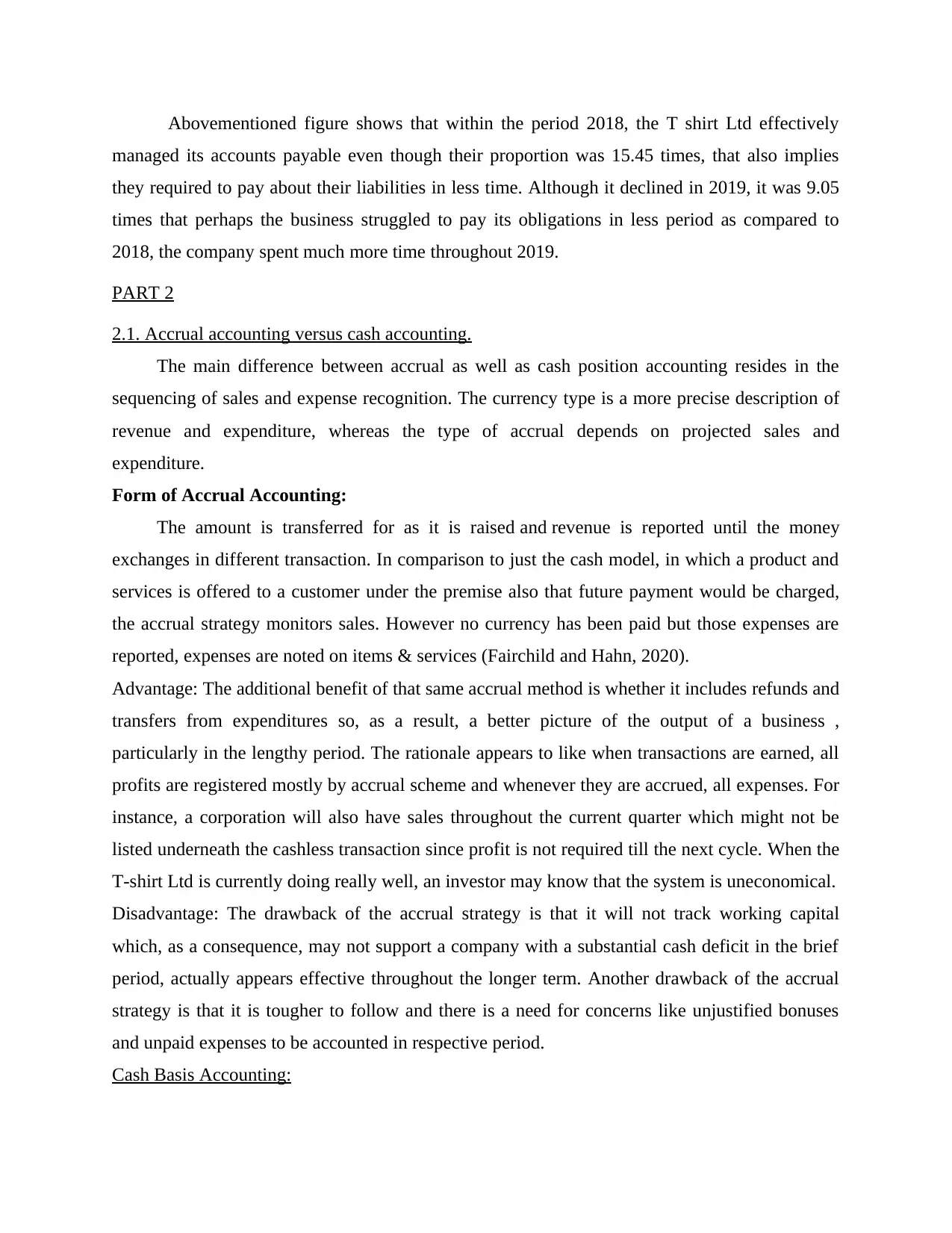
Abovementioned figure shows that within the period 2018, the T shirt Ltd effectively
managed its accounts payable even though their proportion was 15.45 times, that also implies
they required to pay about their liabilities in less time. Although it declined in 2019, it was 9.05
times that perhaps the business struggled to pay its obligations in less period as compared to
2018, the company spent much more time throughout 2019.
PART 2
2.1. Accrual accounting versus cash accounting.
The main difference between accrual as well as cash position accounting resides in the
sequencing of sales and expense recognition. The currency type is a more precise description of
revenue and expenditure, whereas the type of accrual depends on projected sales and
expenditure.
Form of Accrual Accounting:
The amount is transferred for as it is raised and revenue is reported until the money
exchanges in different transaction. In comparison to just the cash model, in which a product and
services is offered to a customer under the premise also that future payment would be charged,
the accrual strategy monitors sales. However no currency has been paid but those expenses are
reported, expenses are noted on items & services (Fairchild and Hahn, 2020).
Advantage: The additional benefit of that same accrual method is whether it includes refunds and
transfers from expenditures so, as a result, a better picture of the output of a business ,
particularly in the lengthy period. The rationale appears to like when transactions are earned, all
profits are registered mostly by accrual scheme and whenever they are accrued, all expenses. For
instance, a corporation will also have sales throughout the current quarter which might not be
listed underneath the cashless transaction since profit is not required till the next cycle. When the
T-shirt Ltd is currently doing really well, an investor may know that the system is uneconomical.
Disadvantage: The drawback of the accrual strategy is that it will not track working capital
which, as a consequence, may not support a company with a substantial cash deficit in the brief
period, actually appears effective throughout the longer term. Another drawback of the accrual
strategy is that it is tougher to follow and there is a need for concerns like unjustified bonuses
and unpaid expenses to be accounted in respective period.
Cash Basis Accounting:
managed its accounts payable even though their proportion was 15.45 times, that also implies
they required to pay about their liabilities in less time. Although it declined in 2019, it was 9.05
times that perhaps the business struggled to pay its obligations in less period as compared to
2018, the company spent much more time throughout 2019.
PART 2
2.1. Accrual accounting versus cash accounting.
The main difference between accrual as well as cash position accounting resides in the
sequencing of sales and expense recognition. The currency type is a more precise description of
revenue and expenditure, whereas the type of accrual depends on projected sales and
expenditure.
Form of Accrual Accounting:
The amount is transferred for as it is raised and revenue is reported until the money
exchanges in different transaction. In comparison to just the cash model, in which a product and
services is offered to a customer under the premise also that future payment would be charged,
the accrual strategy monitors sales. However no currency has been paid but those expenses are
reported, expenses are noted on items & services (Fairchild and Hahn, 2020).
Advantage: The additional benefit of that same accrual method is whether it includes refunds and
transfers from expenditures so, as a result, a better picture of the output of a business ,
particularly in the lengthy period. The rationale appears to like when transactions are earned, all
profits are registered mostly by accrual scheme and whenever they are accrued, all expenses. For
instance, a corporation will also have sales throughout the current quarter which might not be
listed underneath the cashless transaction since profit is not required till the next cycle. When the
T-shirt Ltd is currently doing really well, an investor may know that the system is uneconomical.
Disadvantage: The drawback of the accrual strategy is that it will not track working capital
which, as a consequence, may not support a company with a substantial cash deficit in the brief
period, actually appears effective throughout the longer term. Another drawback of the accrual
strategy is that it is tougher to follow and there is a need for concerns like unjustified bonuses
and unpaid expenses to be accounted in respective period.
Cash Basis Accounting:
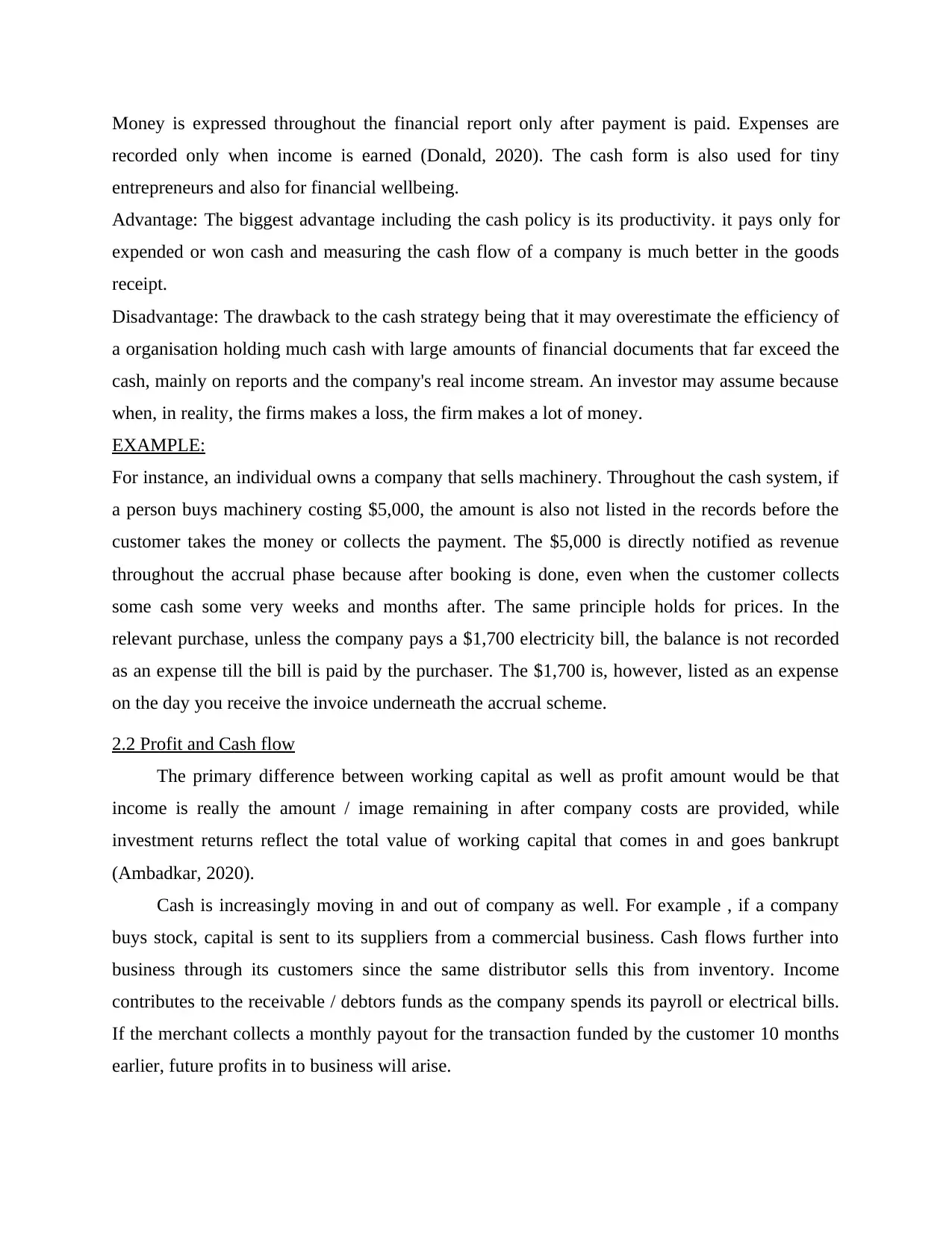
Money is expressed throughout the financial report only after payment is paid. Expenses are
recorded only when income is earned (Donald, 2020). The cash form is also used for tiny
entrepreneurs and also for financial wellbeing.
Advantage: The biggest advantage including the cash policy is its productivity. it pays only for
expended or won cash and measuring the cash flow of a company is much better in the goods
receipt.
Disadvantage: The drawback to the cash strategy being that it may overestimate the efficiency of
a organisation holding much cash with large amounts of financial documents that far exceed the
cash, mainly on reports and the company's real income stream. An investor may assume because
when, in reality, the firms makes a loss, the firm makes a lot of money.
EXAMPLE:
For instance, an individual owns a company that sells machinery. Throughout the cash system, if
a person buys machinery costing $5,000, the amount is also not listed in the records before the
customer takes the money or collects the payment. The $5,000 is directly notified as revenue
throughout the accrual phase because after booking is done, even when the customer collects
some cash some very weeks and months after. The same principle holds for prices. In the
relevant purchase, unless the company pays a $1,700 electricity bill, the balance is not recorded
as an expense till the bill is paid by the purchaser. The $1,700 is, however, listed as an expense
on the day you receive the invoice underneath the accrual scheme.
2.2 Profit and Cash flow
The primary difference between working capital as well as profit amount would be that
income is really the amount / image remaining in after company costs are provided, while
investment returns reflect the total value of working capital that comes in and goes bankrupt
(Ambadkar, 2020).
Cash is increasingly moving in and out of company as well. For example , if a company
buys stock, capital is sent to its suppliers from a commercial business. Cash flows further into
business through its customers since the same distributor sells this from inventory. Income
contributes to the receivable / debtors funds as the company spends its payroll or electrical bills.
If the merchant collects a monthly payout for the transaction funded by the customer 10 months
earlier, future profits in to business will arise.
recorded only when income is earned (Donald, 2020). The cash form is also used for tiny
entrepreneurs and also for financial wellbeing.
Advantage: The biggest advantage including the cash policy is its productivity. it pays only for
expended or won cash and measuring the cash flow of a company is much better in the goods
receipt.
Disadvantage: The drawback to the cash strategy being that it may overestimate the efficiency of
a organisation holding much cash with large amounts of financial documents that far exceed the
cash, mainly on reports and the company's real income stream. An investor may assume because
when, in reality, the firms makes a loss, the firm makes a lot of money.
EXAMPLE:
For instance, an individual owns a company that sells machinery. Throughout the cash system, if
a person buys machinery costing $5,000, the amount is also not listed in the records before the
customer takes the money or collects the payment. The $5,000 is directly notified as revenue
throughout the accrual phase because after booking is done, even when the customer collects
some cash some very weeks and months after. The same principle holds for prices. In the
relevant purchase, unless the company pays a $1,700 electricity bill, the balance is not recorded
as an expense till the bill is paid by the purchaser. The $1,700 is, however, listed as an expense
on the day you receive the invoice underneath the accrual scheme.
2.2 Profit and Cash flow
The primary difference between working capital as well as profit amount would be that
income is really the amount / image remaining in after company costs are provided, while
investment returns reflect the total value of working capital that comes in and goes bankrupt
(Ambadkar, 2020).
Cash is increasingly moving in and out of company as well. For example , if a company
buys stock, capital is sent to its suppliers from a commercial business. Cash flows further into
business through its customers since the same distributor sells this from inventory. Income
contributes to the receivable / debtors funds as the company spends its payroll or electrical bills.
If the merchant collects a monthly payout for the transaction funded by the customer 10 months
earlier, future profits in to business will arise.
⊘ This is a preview!⊘
Do you want full access?
Subscribe today to unlock all pages.

Trusted by 1+ million students worldwide
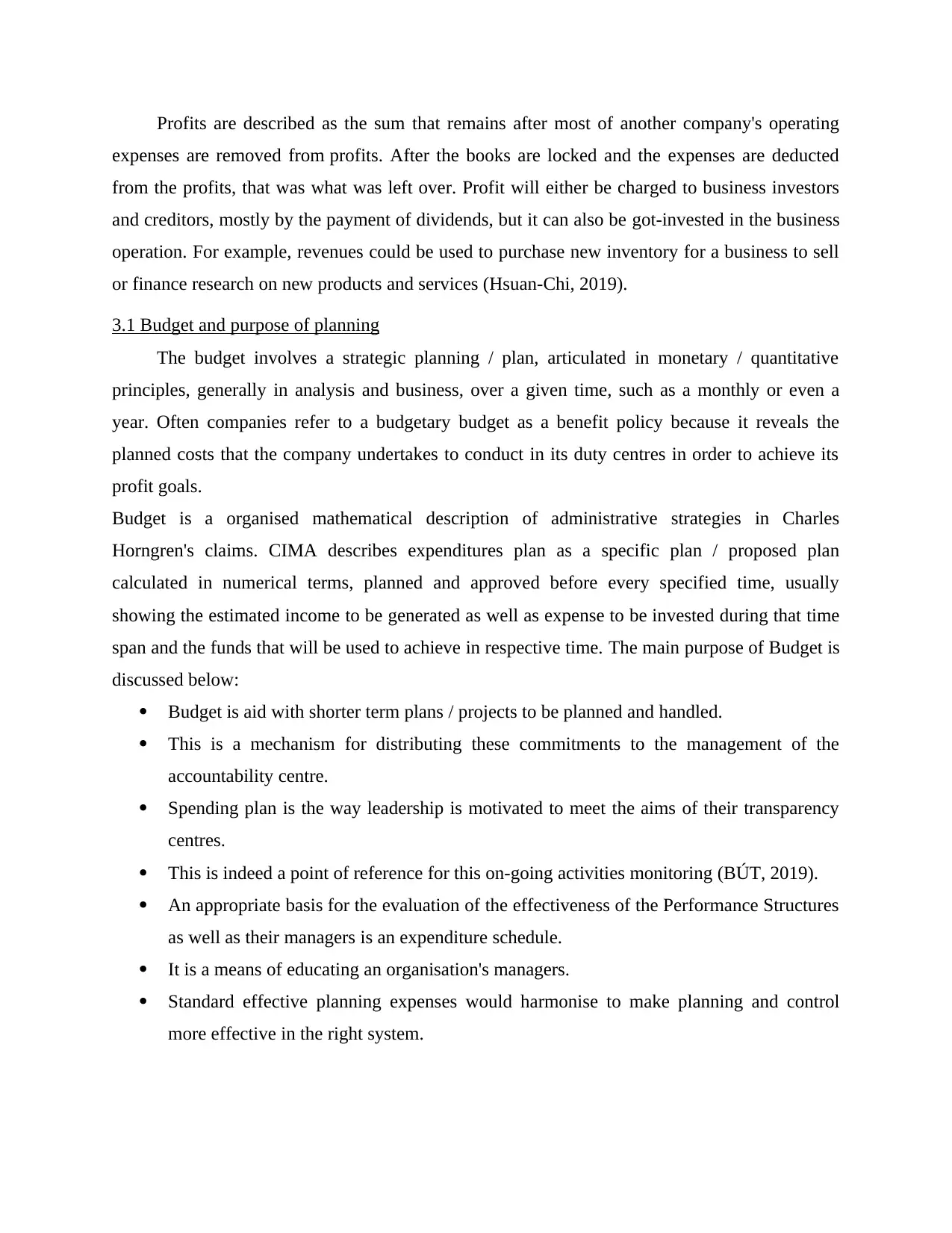
Profits are described as the sum that remains after most of another company's operating
expenses are removed from profits. After the books are locked and the expenses are deducted
from the profits, that was what was left over. Profit will either be charged to business investors
and creditors, mostly by the payment of dividends, but it can also be got-invested in the business
operation. For example, revenues could be used to purchase new inventory for a business to sell
or finance research on new products and services (Hsuan-Chi, 2019).
3.1 Budget and purpose of planning
The budget involves a strategic planning / plan, articulated in monetary / quantitative
principles, generally in analysis and business, over a given time, such as a monthly or even a
year. Often companies refer to a budgetary budget as a benefit policy because it reveals the
planned costs that the company undertakes to conduct in its duty centres in order to achieve its
profit goals.
Budget is a organised mathematical description of administrative strategies in Charles
Horngren's claims. CIMA describes expenditures plan as a specific plan / proposed plan
calculated in numerical terms, planned and approved before every specified time, usually
showing the estimated income to be generated as well as expense to be invested during that time
span and the funds that will be used to achieve in respective time. The main purpose of Budget is
discussed below:
Budget is aid with shorter term plans / projects to be planned and handled.
This is a mechanism for distributing these commitments to the management of the
accountability centre.
Spending plan is the way leadership is motivated to meet the aims of their transparency
centres.
This is indeed a point of reference for this on-going activities monitoring (BÚT, 2019).
An appropriate basis for the evaluation of the effectiveness of the Performance Structures
as well as their managers is an expenditure schedule.
It is a means of educating an organisation's managers.
Standard effective planning expenses would harmonise to make planning and control
more effective in the right system.
expenses are removed from profits. After the books are locked and the expenses are deducted
from the profits, that was what was left over. Profit will either be charged to business investors
and creditors, mostly by the payment of dividends, but it can also be got-invested in the business
operation. For example, revenues could be used to purchase new inventory for a business to sell
or finance research on new products and services (Hsuan-Chi, 2019).
3.1 Budget and purpose of planning
The budget involves a strategic planning / plan, articulated in monetary / quantitative
principles, generally in analysis and business, over a given time, such as a monthly or even a
year. Often companies refer to a budgetary budget as a benefit policy because it reveals the
planned costs that the company undertakes to conduct in its duty centres in order to achieve its
profit goals.
Budget is a organised mathematical description of administrative strategies in Charles
Horngren's claims. CIMA describes expenditures plan as a specific plan / proposed plan
calculated in numerical terms, planned and approved before every specified time, usually
showing the estimated income to be generated as well as expense to be invested during that time
span and the funds that will be used to achieve in respective time. The main purpose of Budget is
discussed below:
Budget is aid with shorter term plans / projects to be planned and handled.
This is a mechanism for distributing these commitments to the management of the
accountability centre.
Spending plan is the way leadership is motivated to meet the aims of their transparency
centres.
This is indeed a point of reference for this on-going activities monitoring (BÚT, 2019).
An appropriate basis for the evaluation of the effectiveness of the Performance Structures
as well as their managers is an expenditure schedule.
It is a means of educating an organisation's managers.
Standard effective planning expenses would harmonise to make planning and control
more effective in the right system.
Paraphrase This Document
Need a fresh take? Get an instant paraphrase of this document with our AI Paraphraser
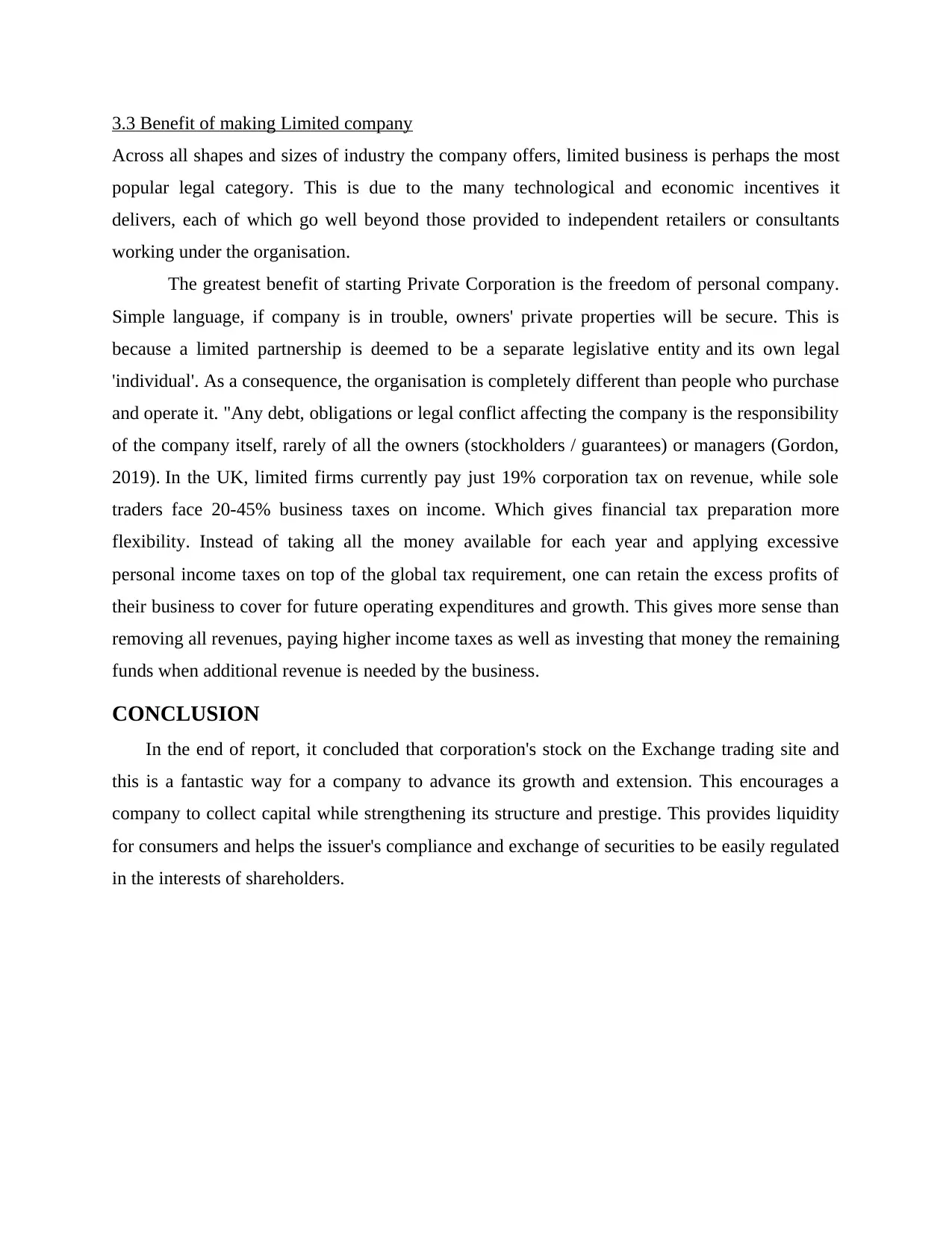
3.3 Benefit of making Limited company
Across all shapes and sizes of industry the company offers, limited business is perhaps the most
popular legal category. This is due to the many technological and economic incentives it
delivers, each of which go well beyond those provided to independent retailers or consultants
working under the organisation.
The greatest benefit of starting Private Corporation is the freedom of personal company.
Simple language, if company is in trouble, owners' private properties will be secure. This is
because a limited partnership is deemed to be a separate legislative entity and its own legal
'individual'. As a consequence, the organisation is completely different than people who purchase
and operate it. "Any debt, obligations or legal conflict affecting the company is the responsibility
of the company itself, rarely of all the owners (stockholders / guarantees) or managers (Gordon,
2019). In the UK, limited firms currently pay just 19% corporation tax on revenue, while sole
traders face 20-45% business taxes on income. Which gives financial tax preparation more
flexibility. Instead of taking all the money available for each year and applying excessive
personal income taxes on top of the global tax requirement, one can retain the excess profits of
their business to cover for future operating expenditures and growth. This gives more sense than
removing all revenues, paying higher income taxes as well as investing that money the remaining
funds when additional revenue is needed by the business.
CONCLUSION
In the end of report, it concluded that corporation's stock on the Exchange trading site and
this is a fantastic way for a company to advance its growth and extension. This encourages a
company to collect capital while strengthening its structure and prestige. This provides liquidity
for consumers and helps the issuer's compliance and exchange of securities to be easily regulated
in the interests of shareholders.
Across all shapes and sizes of industry the company offers, limited business is perhaps the most
popular legal category. This is due to the many technological and economic incentives it
delivers, each of which go well beyond those provided to independent retailers or consultants
working under the organisation.
The greatest benefit of starting Private Corporation is the freedom of personal company.
Simple language, if company is in trouble, owners' private properties will be secure. This is
because a limited partnership is deemed to be a separate legislative entity and its own legal
'individual'. As a consequence, the organisation is completely different than people who purchase
and operate it. "Any debt, obligations or legal conflict affecting the company is the responsibility
of the company itself, rarely of all the owners (stockholders / guarantees) or managers (Gordon,
2019). In the UK, limited firms currently pay just 19% corporation tax on revenue, while sole
traders face 20-45% business taxes on income. Which gives financial tax preparation more
flexibility. Instead of taking all the money available for each year and applying excessive
personal income taxes on top of the global tax requirement, one can retain the excess profits of
their business to cover for future operating expenditures and growth. This gives more sense than
removing all revenues, paying higher income taxes as well as investing that money the remaining
funds when additional revenue is needed by the business.
CONCLUSION
In the end of report, it concluded that corporation's stock on the Exchange trading site and
this is a fantastic way for a company to advance its growth and extension. This encourages a
company to collect capital while strengthening its structure and prestige. This provides liquidity
for consumers and helps the issuer's compliance and exchange of securities to be easily regulated
in the interests of shareholders.
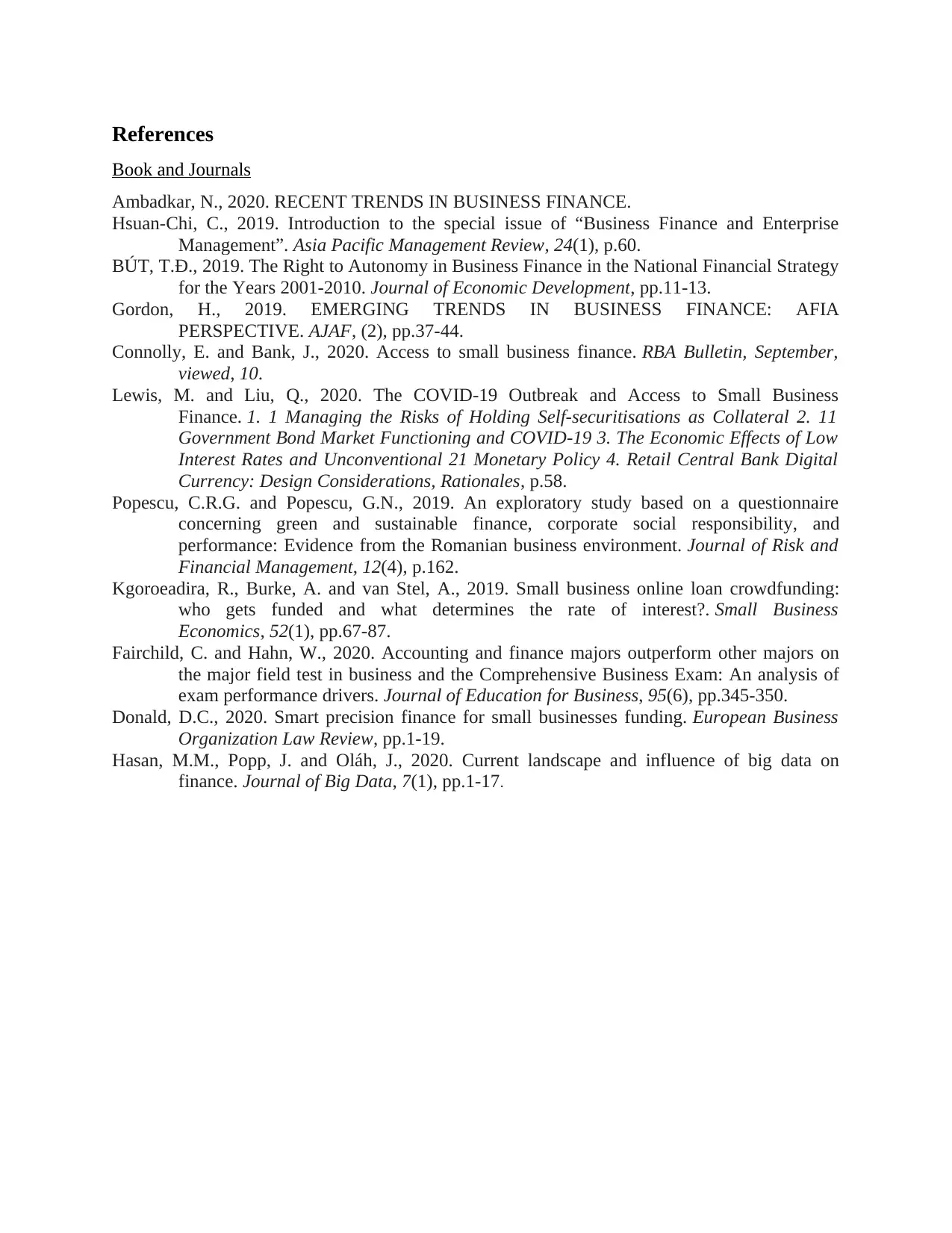
References
Book and Journals
Ambadkar, N., 2020. RECENT TRENDS IN BUSINESS FINANCE.
Hsuan-Chi, C., 2019. Introduction to the special issue of “Business Finance and Enterprise
Management”. Asia Pacific Management Review, 24(1), p.60.
BÚT, T.Đ., 2019. The Right to Autonomy in Business Finance in the National Financial Strategy
for the Years 2001-2010. Journal of Economic Development, pp.11-13.
Gordon, H., 2019. EMERGING TRENDS IN BUSINESS FINANCE: AFIA
PERSPECTIVE. AJAF, (2), pp.37-44.
Connolly, E. and Bank, J., 2020. Access to small business finance. RBA Bulletin, September,
viewed, 10.
Lewis, M. and Liu, Q., 2020. The COVID-19 Outbreak and Access to Small Business
Finance. 1. 1 Managing the Risks of Holding Self-securitisations as Collateral 2. 11
Government Bond Market Functioning and COVID-19 3. The Economic Effects of Low
Interest Rates and Unconventional 21 Monetary Policy 4. Retail Central Bank Digital
Currency: Design Considerations, Rationales, p.58.
Popescu, C.R.G. and Popescu, G.N., 2019. An exploratory study based on a questionnaire
concerning green and sustainable finance, corporate social responsibility, and
performance: Evidence from the Romanian business environment. Journal of Risk and
Financial Management, 12(4), p.162.
Kgoroeadira, R., Burke, A. and van Stel, A., 2019. Small business online loan crowdfunding:
who gets funded and what determines the rate of interest?. Small Business
Economics, 52(1), pp.67-87.
Fairchild, C. and Hahn, W., 2020. Accounting and finance majors outperform other majors on
the major field test in business and the Comprehensive Business Exam: An analysis of
exam performance drivers. Journal of Education for Business, 95(6), pp.345-350.
Donald, D.C., 2020. Smart precision finance for small businesses funding. European Business
Organization Law Review, pp.1-19.
Hasan, M.M., Popp, J. and Oláh, J., 2020. Current landscape and influence of big data on
finance. Journal of Big Data, 7(1), pp.1-17.
Book and Journals
Ambadkar, N., 2020. RECENT TRENDS IN BUSINESS FINANCE.
Hsuan-Chi, C., 2019. Introduction to the special issue of “Business Finance and Enterprise
Management”. Asia Pacific Management Review, 24(1), p.60.
BÚT, T.Đ., 2019. The Right to Autonomy in Business Finance in the National Financial Strategy
for the Years 2001-2010. Journal of Economic Development, pp.11-13.
Gordon, H., 2019. EMERGING TRENDS IN BUSINESS FINANCE: AFIA
PERSPECTIVE. AJAF, (2), pp.37-44.
Connolly, E. and Bank, J., 2020. Access to small business finance. RBA Bulletin, September,
viewed, 10.
Lewis, M. and Liu, Q., 2020. The COVID-19 Outbreak and Access to Small Business
Finance. 1. 1 Managing the Risks of Holding Self-securitisations as Collateral 2. 11
Government Bond Market Functioning and COVID-19 3. The Economic Effects of Low
Interest Rates and Unconventional 21 Monetary Policy 4. Retail Central Bank Digital
Currency: Design Considerations, Rationales, p.58.
Popescu, C.R.G. and Popescu, G.N., 2019. An exploratory study based on a questionnaire
concerning green and sustainable finance, corporate social responsibility, and
performance: Evidence from the Romanian business environment. Journal of Risk and
Financial Management, 12(4), p.162.
Kgoroeadira, R., Burke, A. and van Stel, A., 2019. Small business online loan crowdfunding:
who gets funded and what determines the rate of interest?. Small Business
Economics, 52(1), pp.67-87.
Fairchild, C. and Hahn, W., 2020. Accounting and finance majors outperform other majors on
the major field test in business and the Comprehensive Business Exam: An analysis of
exam performance drivers. Journal of Education for Business, 95(6), pp.345-350.
Donald, D.C., 2020. Smart precision finance for small businesses funding. European Business
Organization Law Review, pp.1-19.
Hasan, M.M., Popp, J. and Oláh, J., 2020. Current landscape and influence of big data on
finance. Journal of Big Data, 7(1), pp.1-17.
⊘ This is a preview!⊘
Do you want full access?
Subscribe today to unlock all pages.

Trusted by 1+ million students worldwide
1 out of 12
Related Documents
Your All-in-One AI-Powered Toolkit for Academic Success.
+13062052269
info@desklib.com
Available 24*7 on WhatsApp / Email
![[object Object]](/_next/static/media/star-bottom.7253800d.svg)
Unlock your academic potential
Copyright © 2020–2025 A2Z Services. All Rights Reserved. Developed and managed by ZUCOL.





